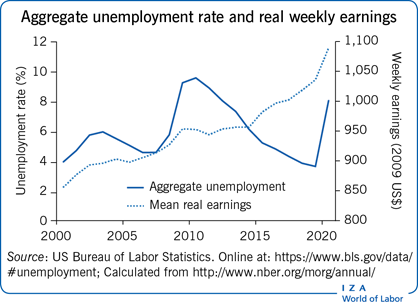Elevator pitch
As the largest economy in the world, the US labor market is crucial to the economic well-being of citizens worldwide as well as, of course, that of its own citizens. Since 2000 the US labor market has undergone substantial changes, reflecting the Great Recession and the Covid Recession, but also resulting from some striking trends. Most interesting have been a remarkable drop in the labor force participation rate, reversing a nearly 50-year trend; the full recovery of unemployment after 2010 and its skyrocketing in 2020; and the little-known continuing growth in post-inflation average earnings.

Key findings
Pros
Unemployment is slowly recovering from its Covid Recession peak.
The job vacancy rate near the end of the Covid Recession is the highest since data have been collected and exceeds the hiring rate.
Labor force participation of men and women aged 20–54 has fallen, so that in 2020 the labor force has ten million fewer people than were expected in 2000.
Real earnings of the average- and median-earning full-time worker have risen.
Women’s wages have risen relative to those of men but remain somewhat below.
Cons
Even at full employment in 2019, long-term unemployment was much greater than at similar points of past business cycles.
Youth unemployment remains far above the adult average.
Labor force participation of men and women aged 20–54 has fallen, so that in 2020 the labor force has ten million fewer people than were expected in 2000.
Inequality is high, but unchanged over the last few years.
Wages of African-Americans remain far below those of white Americans and no higher than in the early 2000s.